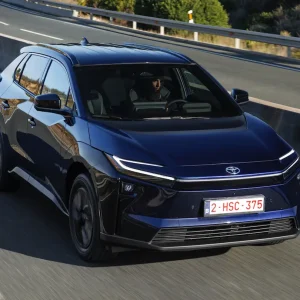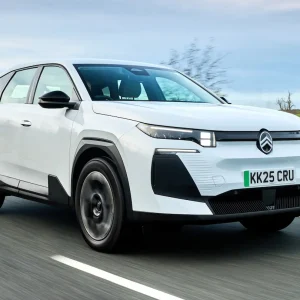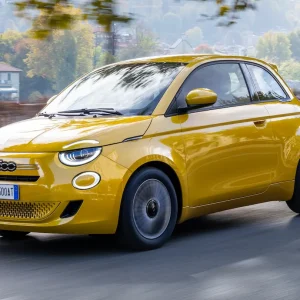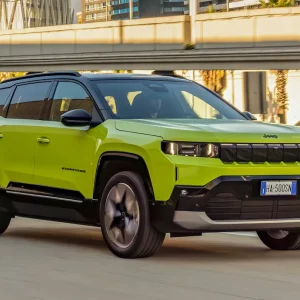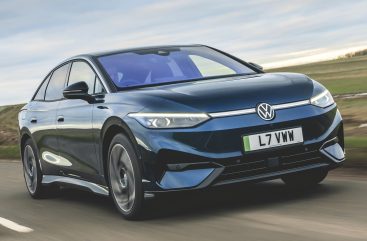
Volkswagen is claiming the ID.7 is the most advanced, capacious, and luxurious member of its EV ID. family. Look past this, and in simple terms, it’s a long mid-size saloon Tesla Model 3 rival, built on the same MEB modular electric drive platform as the ID.3 and ID.4.
Outside, the ID.7’s design is best summed up as long and sleek. At 4,961mm, the ID.7 is the largest electric passenger car yet to be offered by Volkswagen. From the front, with its LED headlights, and light bar it looks familiar – but different.
The silhouette is more interesting, and the curved windscreen frame at the front and the bent, coupe-like rear C-pillar, both trimmed in aluminium, stand out. More distinctive is the character line below the windows, and the lower undercut that gives a real kick upwards to the flanks. The standard 19in alloy wheels look a bit lost under the ID.7’s arches, but 20in wheels are an option. The rear design is very horizontal, with a high-set LED light strip. There’s also a subtle diffuser at the bottom of the rear bumper.
Overall, it’s an attractive if predictable effort – rivals such as the BYD Seal and Hyundai Ioniq 6 have more presence. However, in Volkswagen’s defence, the ID.7’s overall design is better detailed.
Inside, the ID.7 nods to its high-quality Volkswagen roots, where perhaps previous ID. products have been lacking. All the key touchpoints, such as the top of the dashboard, door cards and centre console are finished in soft-touch plastics, although we feel some should still be softer.
The driving position is lower and more car-like than the Ioniq 6. The optional Ergoactive seats have multiple massage functions, are heated, and are very comfortable too. The vertical dashboard is dominated by the 15in touchscreen, now thankfully with backlit bottom sliders, with more customisable functions, tile home screen and online voice assistant to work with ChatGPT. The jury is out on how useful the incoming ChatGPT compatibility will be. Still, it’s simple to operate, but some key functions such as the heating and ventilation are more than one tap away. The information screen in front of the driver looks and feels a bit of an afterthought, but the head-up display is excellent.
Move to the back, and the limo-like levels of rear space impress – along with the flat floor, which feels far more comfortable. Then there’s the 532-litre boot, with its practical hatch opening. With all this space, surely the ID.7 will appeal to the premium cab industry.
The ID.7 might share its platform, but this Volkswagen EV debuts the new and more efficient drive system, called the APP550. Central to this is a new electric motor, which with 282hp and 545Nm of torque, Volkswagen claims is its most powerful and highest-torque motor yet. It allows 0-62mph in 6.5 seconds. A version with a larger 86kWh battery will follow, but this car with its 77kWh battery is capable of a range of up to 384 miles. When it’s time to charge, all ID.7s can take AC and DC charging up to 175kW, which is good enough to equal a 10-80% charge in under 30 minutes.
On the road, it seems the ID.7 is all about comfort rather than driver involvement – even though our car had the optional, tuneable DCC suspension. Maybe the incoming performance GTX will bring more spark. In ‘Comfort’ mode it is pleasingly easy going in everyday driving. ‘Sport’ mode didn’t seem to change much other than stiffening up the ride and sharpening the throttle, and this is where you notice its 2.1-tonne weight the most. The BMW i4 or BYD Seal are more fun to drive.
The ID.7 is the best EV from Volkswagen yet. It has a spacious and well-equipped interior, quality is more in line with the badge, and it has an impressive EV range.
Volkswagen ID.7 Pro Launch Edition
P11D: £55,515
Residual value: 40.4%
Depreciation: £32,265
Fuel: £3,504
Service, maintenance and repair: £2,990
Cost per mile: 64.59p
Range: 382 miles
CO2 (BIK %): 0g/km (2%)
BIK 20/40% a month: £18/£37
Luggage capacity: 532 litres
Battery size/power: 77kWh/282hp

